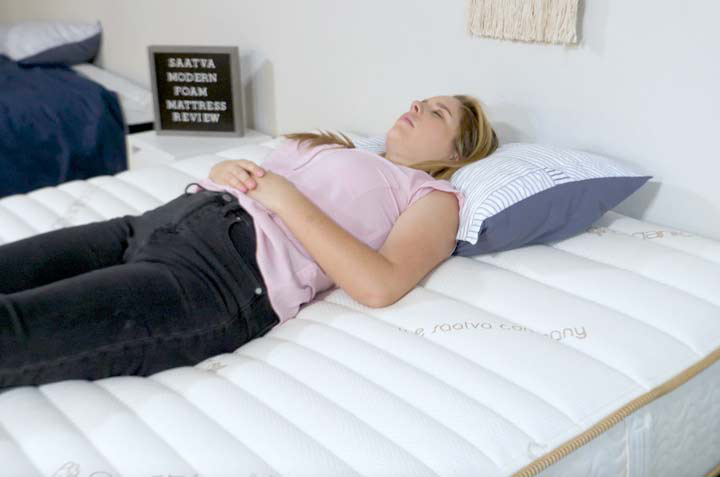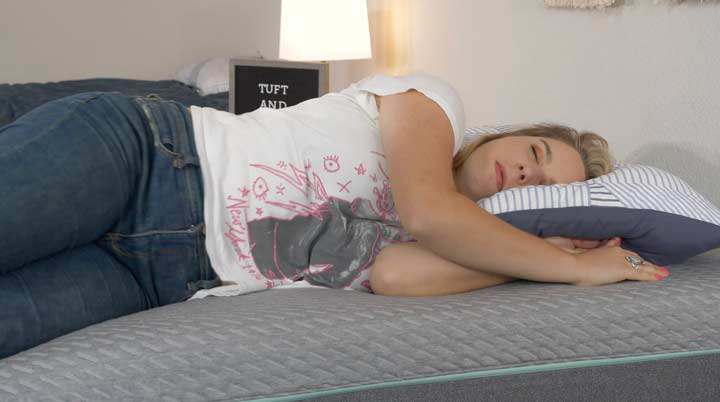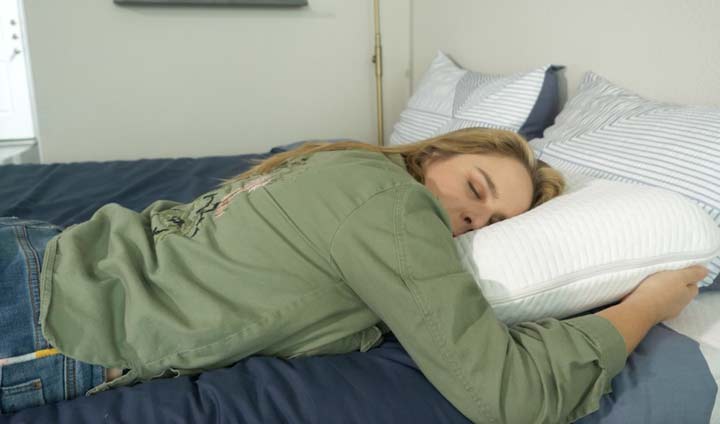If you’re like most people, you probably don’t think about your sleeping position. As soon as your head hits the pillow, it’s time to relax into a deep slumber.
Even though it may not be top of mind, your sleeping position plays a big role in your sleep quality and overall health. For some people, back sleeping can alleviate chronic issues. But how do you train yourself to sleep on your back? We’ll share our favorite tips and tricks.
Benefits of Sleeping On Your Back
Back sleeping isn’t for everyone. Some folks, like those with sleep disorders, may want to rest in another sleeping position. Before you change your sleep habits, take a moment to assess whether back sleeping is right for you.
And remember – this shouldn’t replace medical advice. If you suffer from a health condition, consult with your doctor before changing the way you sleep.
Who Should Sleep On Their Back?
- Those Who Experience Frequent Tension Headaches
- People With Blocked Sinuses
- Those Who Want To Avoid Face Wrinkles and Creases
Who Shouldn’t Sleep On Their Back?
- Pregnant People
- People With Sleep Apnea
- Those Who Snore
- People With Heartburn
How To Train Yourself To Sleep On Your Back
It often takes several weeks to create a new habit. If you’ve decided to give back sleeping a try, you may need to train your body to relax in this sleeping position. Here are a few easy ways to make the switch:
Place a Pillow Under Your Knees
Some people find it easier to rest on their backs when they place a supportive pillow under their knees. If you try this method, make sure your knees are only slightly bent and ensure your neck and spine are in alignment.
Use a Pillow as a Barrier
Pillows can work wonders when you’re trying to change your sleeping position. If you find yourself unintentionally moving to your side or stomach at night, place several pillows around yourself. This will create a barrier and act as a gentle reminder to return to your back.
Get a More Supportive Mattress
In order to maintain the proper spinal alignment, back sleepers need beds that offer both comfort and support. We recommend medium-firm mattresses that fall within 6.5-7/10 on our firmness scale. If your mattress is softer than that, you won’t get the necessary lumbar support and might want to switch over to your side to feel more comfortable.

Find the Proper Pillow
Maybe your pillow is the culprit! Back sleepers need pillows that keep their necks in the correct position. An easy rule of thumb is to check that your chin aligns with your sternum. If your pillow is flat like a pancake, your head will crane backward. And If you have a lofty pillow, your chin will jut forward.
Take a look at our list of the best pillows for back sleepers for some great options.
Spread Out Your Arms and Legs
If you sleep solo, try adopting the “starfish position.” When you spread out your arms and legs across the mattress, you’ll take up about ¾ of the available space. This will help remind your body to lie flat on your back, and you might find it feels comfy and relaxing!
What’s The Healthiest Sleeping Position?
Just like mattresses, sleeping positions aren’t one-size-fits-all. Your ideal sleeping position depends on several different health factors. Let’s examine each one and see who they may work well for:
Back Sleeping
Eases Back and Hip Pain – Back sleeping can help keep your spine in a neutral position and alleviate hip pain.
- Helps You Breathe Better – Back sleeping can also help people breathe easier. When you rest on your side or stomach, you may crowd the muscles around your main breathing muscle, the diaphragm. Deep diaphragmatic breathing has been linked to reduced stress and improved mood. Taking slow breaths may also help produce melatonin, the sleep hormone.
- Better For Your Skin – When your head presses against your pillow at night, you have a higher risk of breaking out in acne and getting wrinkles across your face. And because of the way fluids move around at night, side and back sleepers may wake up looking puffy and swollen.
- Clears Sinuses – When seasonal allergies strike, try resting on your back with your head elevated. This can help naturally drain mucus and clear your airways.
- Can Help Prevent Tension Headaches – Side and stomach sleeping places a significant amount of pressure on your head, which can lead to tension headaches. To relieve this pain, try switching to your back when you sleep. This can also help folks deal with the other annoying side effects of tension headaches such as stiff necks, eye pain, blurry vision, and upset stomachs.
Side Sleeping
An estimated 74% of the population sleeps on their sides for at least a portion of the night. For some folks, this sleeping position can greatly improve their wellbeing. Here are some of the benefits:
- Helps During Pregnancy – It’s easier for the heart to pump blood when you rest on your side, so doctors recommend this sleeping position for pregnant people. But should you sleep on your right side or your left side? The results aren’t entirely conclusive, but most doctors believe that sleeping on your left side has more health benefits.
- Helps Prevent Snoring And Helps With Sleep Apnea – Side sleeping helps open nasal passageways which can prove helpful for folks who snore or have sleep apnea. When you rest on your back, your tongue may fall back into your throat and obstruct airways.
- Soothes Heartburn – According to a 1994 study, sleeping on your left side may alleviate heartburn because it limits the amount of acid exposed to the esophagus.

Stomach Sleeping
Stomach sleeping may help some people stop snoring, but it has far more drawbacks than advantages.
- Strains the Neck – Because most people turn their heads to the left or right side while stomach sleeping, this can lead to neck and shoulder pain.
- Hurts The Spine – Oftentimes, when people rest on their stomachs, their spines sink out of alignment. This not only leads to pain and stiffness – it can also cause numbness in different parts of the body. If you rest on your stomach, it’s important to find a firm mattress that can prevent your hips from sinking out of alignment. Check out our list of the best mattresses for stomach sleepers for some ideas.

FAQs
We won’t leave you hanging! Take a look at our FAQ section for even more information.
Why can’t I sleep on my back?
There are many reasons people can’t sleep on their backs. For some, it’s become a habit that’s difficult to change. Others, like those with sleep apnea, may find it uncomfortable to rest in this position. If you don’t feel like your sleeping position is hindering your day-to-day life, there’s no need to switch it up. But if you would like to make a change, we have several helpful tips and tricks.
Is it possible to teach yourself to sleep on your back?
It absolutely is! Creating a new habit takes time, but with a few techniques, you can change your sleeping position for good. You could try placing pillows around your body to act as a barrier while you sleep. It could also prove beneficial to get a lower loft pillow and medium-firm mattress.
How do I stop being a stomach sleeper?
Stomach sleeping can lead to back pain, so it’s not the most popular position. If you want to leave the stomach sleepers’ club, there are many ways you can train yourself to rest on your back or side.
First of all, simply try falling asleep in a different position. Your body may feel comfortable there, and you may not find yourself switching back to your stomach in the middle of the night.
If that doesn’t work, consider sleeping with a <a href="https://www.mattressclarity.com/bedding/pillows/best-body-pillows/. Stomach sleepers often like resting their entire body against the mattress, and body pillows help recreate this feeling.
You may also need a new bed pillow! Stomach sleepers typically need low loft pillows in order to keep their spines in alignment. If you try sleeping on your side, you’ll need more neck support. Check out our list of the best pillows for side sleepers for some ideas.

